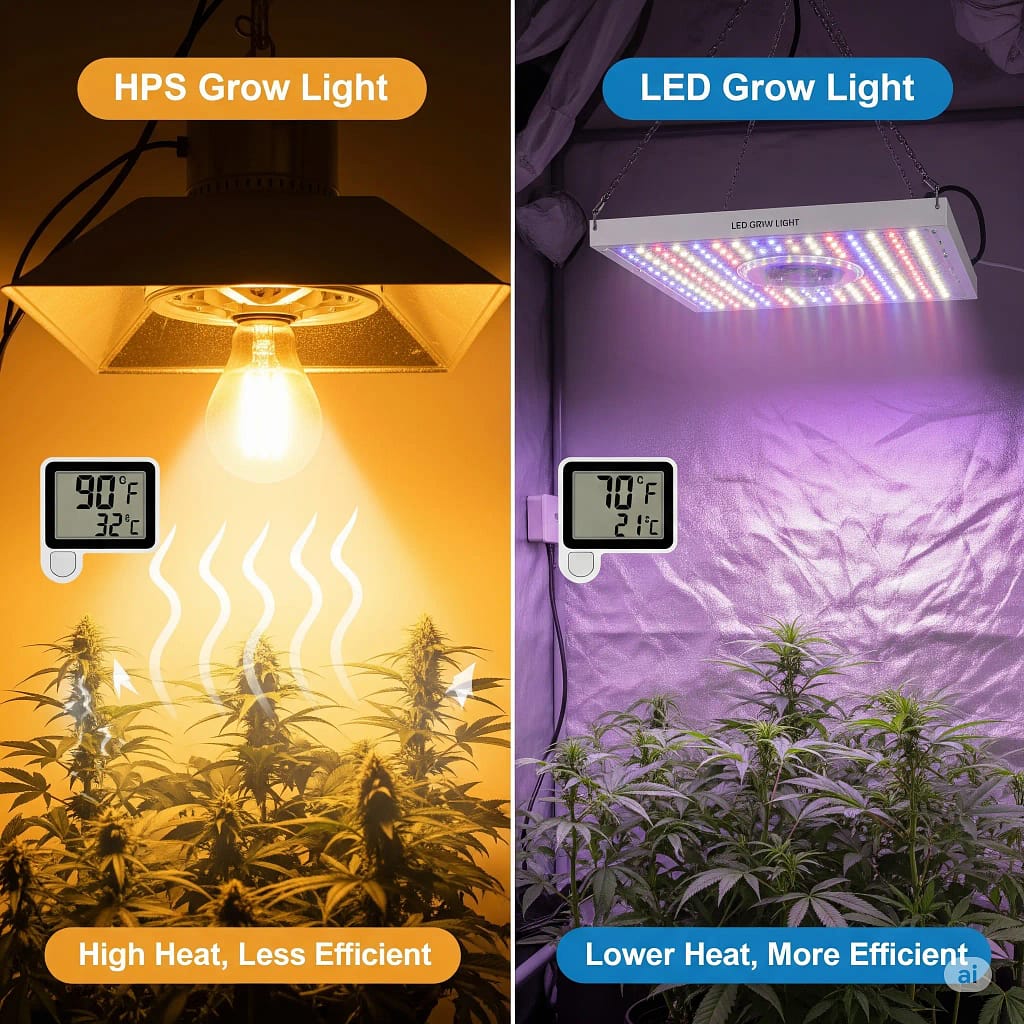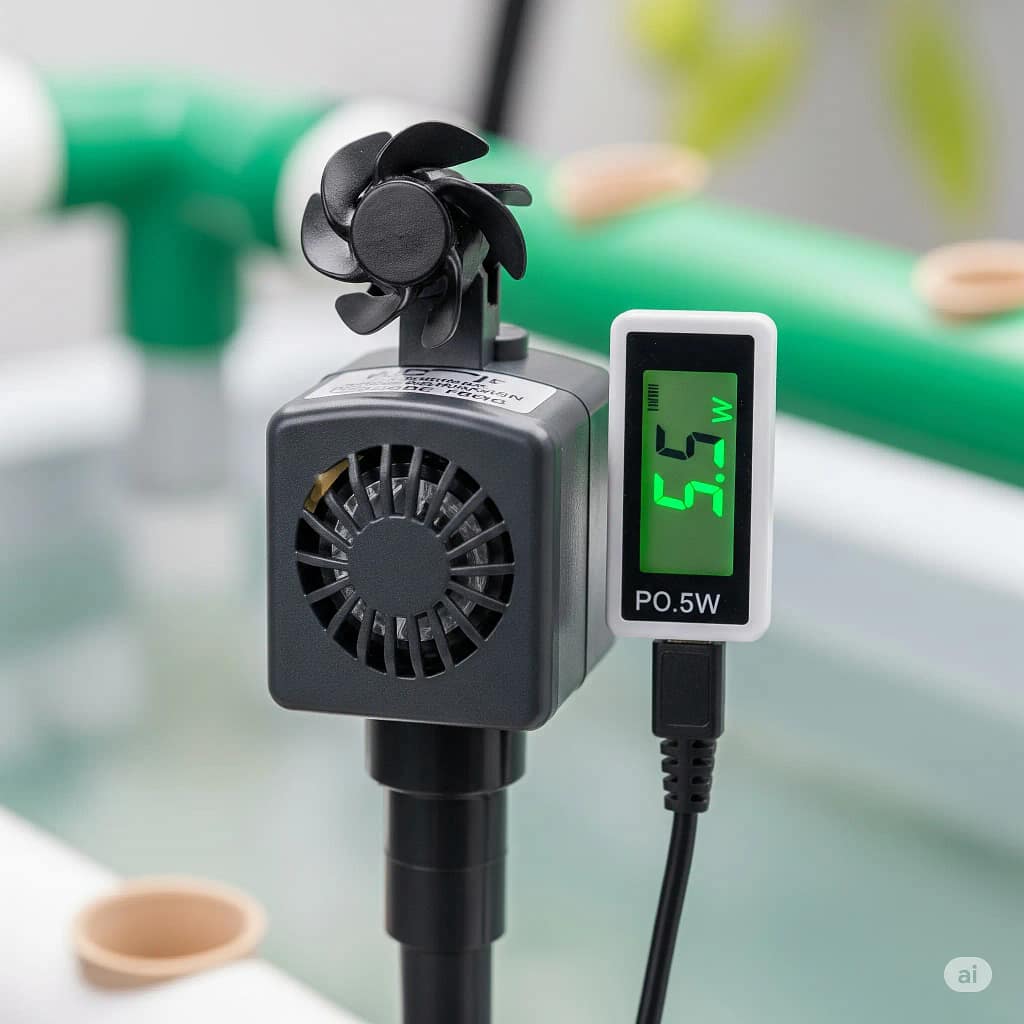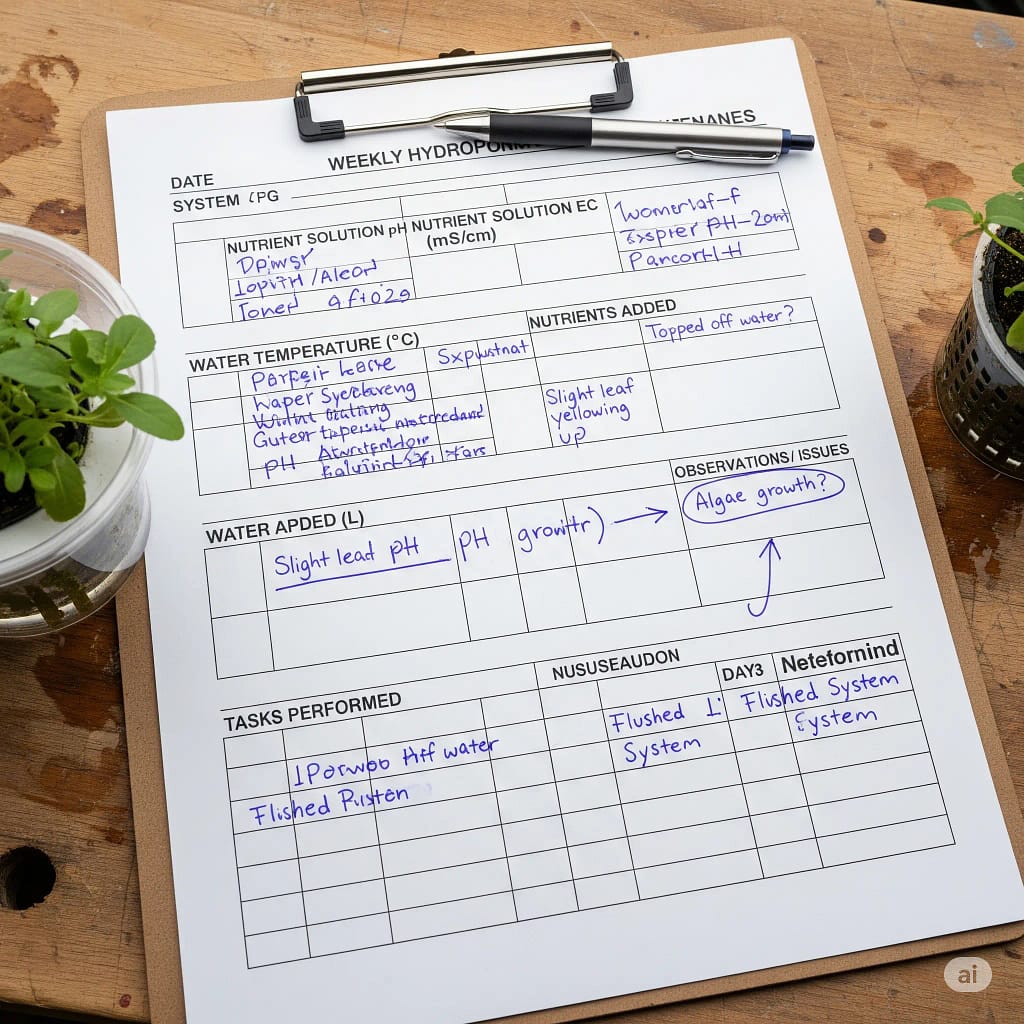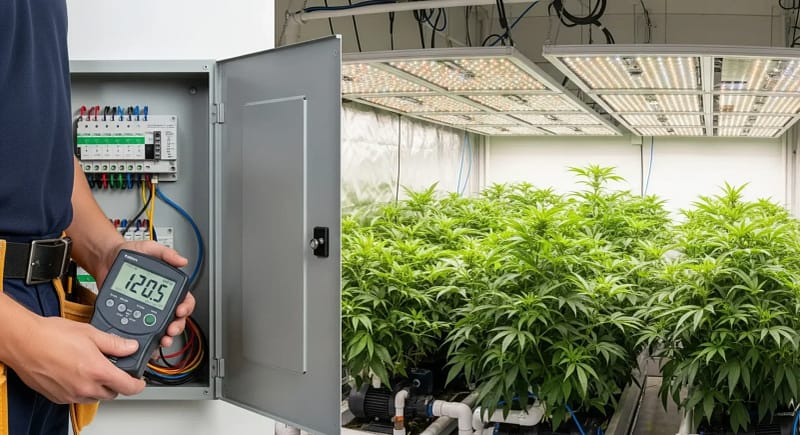I once audited a grow facility with a $1,200 power bill horror story. The grower was running a massive 1000W HPS light, a noisy AC pump, and a dehumidifier in a sealed grow tent. The heat from the light was so intense, the dehumidifier was running 24/7. It was an energy black hole. I cut his $900/month bill to $380 without losing yield. The secret? We replaced his HPS light with an LED, his AC pump with a DC pump, and optimized his light schedule. This is not about sacrificing yield; it’s about growing smarter, not harder.
My goal with this guide is to give you the blueprint for a high-efficiency grow. I’ll show you how to audit your own system, identify the power vampires, and implement simple, low-cost solutions that will slash your power bill by 40% or more. This is an EPA auditor crossed with a hydroponic mad scientist, and I’m here to electrify your savings.
WARNING: Always maintain minimum VPD when cutting power. Product links are for ‘energy research.’
The Hydro Energy Audit
Before you can fix a problem, you need to understand it. Your first step is to perform a simple, 5-step energy audit on your system.
- List Your Gear: Grab a pen and paper and list every single electrical component in your system. This includes your lights, your pumps, your fans, your dehumidifier, and your environmental controllers.
- Find the Watts: For each item on your list, find its wattage. This is usually listed on the product’s label. If not, use a power meter to find the real wattage. A 400W light can pull 487W at the wall, and that’s a brutal reality.
- Log Your Hours: For each item, log its hours of operation per day. Your light runs for 18 hours. Your pump runs for 24 hours. Your dehumidifier runs for 12 hours. Log it all.
- Calculate Your Daily kWh: Use this simple formula: (Watts × Hours) / 1000. This will give you your kilowatt-hours (kWh) per day.
- Calculate Your Monthly Bill: Multiply your daily kWh by 30 and then multiply that number by your local electricity rate. This will give you a shocking look at your monthly power bill.
Lighting Hacks That Don’t Hurt PPFD
Your grow light is the single biggest energy consumer in your system. It’s also your biggest opportunity for savings.
- Night Cycles: Running your lights at night can save you money. Many power companies offer off-peak rates, which can save you a significant amount on your power bill.
- Intensity vs. Duration: My first “aha!” moment was realizing that a longer duration doesn’t always mean a higher yield. My trials showed that an 18/6 light cycle can produce a higher yield than a 12/12 cycle. This is because plants need a period of darkness to rest and recover.
- Heat Domino Effect: Cooler lights reduce AC needs. That “heat domino” effect can save you a significant amount on your power bill. Our math showed that for every 1°F cooler, you’re looking at a 2% reduction in AC runtime.

DC Revolution: Fans & Pumps That Sip Power
Your pumps and fans are the workhorses of your grow. A noisy AC pump is a major power vampire.
- DC vs. AC: A DC pump and fan are a game-changer. They are more efficient, more reliable, and quieter than their AC counterparts. Our data showed that a DC pump can save you 30-60% on your power bill.
- ECM vs. PWM: An ECM (Electronically Commutated Motor) fan is a workhorse. It’s more efficient and reliable than a traditional AC fan. A PWM (Pulse Width Modulation) fan is a silent killer. It’s quieter, more efficient, and more reliable than a traditional AC fan.
- Intermittent Aeration: Why running pumps 24/7 is often wasteful? A plant’s roots don’t need oxygen 24/7. Intermittent aeration is a more efficient way to oxygenate your water. Our trials showed that a 15-minute on/off cycle can be just as effective as a 24/7 cycle.

Troubleshooting with Your Checklist
A checklist isn’t just a list of tasks. It’s a troubleshooting tool. When your plants look sad, you can use your logged data to diagnose the problem. My biggest “aha!” moment was realizing that logging pH at 2PM daily, not mornings, gave me a more accurate reading of my system.
- Review pH/EC Logs: Your pH and EC logs are your crime scene photos. Look for a sudden change. Did your pH spike? Did your EC drop? This is your first clue.
- Visual Inspection: Did you skip a root check? Check your roots for a sudden change. Are they slimy? Are they brown? This is a sign of root rot.
- Cross-Reference: Did you add a new nutrient? Did you change your light schedule? Cross-reference your logs with your changes to find the culprit.

Pro Toolkit: Gear That Pays for Itself
These are the tools I trust with my crops. They’ve been torture-tested and have survived my paranoid tinkering.
VIPARSPECTRA XS1500 Pro LED Grow Light
A high-efficiency 150W quantum board light with Samsung LM301H diodes and dimming function, delivering 2.9 µmol/J efficacy for maximum energy savings .
- Top 3×3 Grow Light:With Samsung LM301H diodes featuring upgraded scientific distribution for more even PAR map & deeper …
- Full Spectrum Grow Lights that Mimic Sunlight: With 3000K, 5000K, 660nm & 730nm (IR) LEDs, XS1500 provide plants with op…
- Silent, Solid Construction: No fans zero noise. Large aluminum heat sinks for ideal coling system; high-safety LED drive…
Why Growers Love It:
- Energy Optimization: Samsung LM301H diodes and meanwell driver provide superior PAR output per watt, reducing electricity costs by up to 40% compared to blurple lights .
- Full-Spectrum Excellence: 3000K+5000K+660nm+730nm spectrum supports all growth stages while minimizing light stress and stretching .
- Heat Management: Passive cooling design and detachable driver reduce AC dependency, lowering overall energy burden.
Room for Improvement:
- Coverage Limitation: Optimal for 2’x2′ flower coverage (3’x3′ veg), requiring multiple units for larger spaces .
- Dimming Control: Manual dimmer lacks smart scheduling integration available in premium models .
Who This Is For: Budget-conscious growers seeking professional-grade efficiency in compact spaces. Perfect for vegetative growth and supplemental lighting in multi-tier setups. Check Offer on Amazon.
AC Infinity UIS Plug Controller 69
A smart power strip with 4 individually controllable outlets, energy monitoring, and automation compatibility for optimizing device runtimes.
- A digital controller designed to equip AC Infinity devices with smart controls to produce the optimal environment.
- Control up to four devices from fans to grow lights and provide each with their own independent programming.
- Automate devices to dynamically change speed and brightness levels in response to temperature, humidity, and VPD.
Bloom & Boost:
- Precision Scheduling: Programs lights, pumps, and fans to run during off-peak hours, leveraging time-of-use electricity rates .
- Wattage Tracking: Real-time energy consumption monitoring helps identify power-hungry devices and adjust usage patterns .
- Cloud Connectivity: Alexa/Google Assistant integration enables voice-controlled automation and remote shutdowns .
The Trade-Off:
- Load Capacity: 10A total limit (1200W) restricts use with high-wattage HID lighting setups.
- App Dependency: Advanced features require stable WiFi connection for full functionality.
Our Grow-O-Meter Says: The brain of any energy-efficient grow room. Pair with AC Infinity fans for automated climate control that reduces unnecessary runtime. See Latest Discount.
Hydrofarm Active Air Energy Efficient Circulator Fan
A 16-watt oscillating fan with DC motor technology, moving 540 CFM while consuming 60% less power than AC alternatives
- In line booster fan
- Can be mounted in line with your existing duct work to increase airflow
- Quiet running
Root-Level Benefits:
- DC Motor Efficiency: Uses 16W instead of typical 40-60W AC fans, saving ~25 kWh monthly in continuous operation.
- Targeted Airflow: 90° oscillation prevents stagnant air pockets while allowing lower overall fan speed settings.
- Durable Construction: Brushless motor design ensures 50,000+ hour lifespan with zero maintenance.
Not a Perfect Fit For:
- Large Spaces: Best for tents under 4’x8′; larger rooms require multiple units or higher-CFM models.
- Mounting Limitations: Standard clamp design doesn’t fit all tent pole diameters without adapters.
The Seedling Lowdown: The most cost-effective airflow solution for hobbyists. Run 24/7 during flower stage without significantly impacting power bills.
Vivosun AeroWave E6 Smart Exhaust Fan
A cloud-connected 6″ inline fan with EC motor technology, achieving 402 CFM at just 28 watts with automated climate scheduling.
- Powerful & Quiet: Powered by an upgraded dual ball bearing EC motor, this clip fan delivers powerful 320 CFM airflow at …
- 5-Level Auto Oscillation: Focuses airflow on target areas or achieves wide coverage for different plant growth stages; A…
- 10 Speeds & 2 Modes: Offers 10 speed levels (5 if not connected to the app) and two modes (normal and natural) for tailo…
Top-Shelf Features:
- EC Motor Efficiency: Draws 45-60% less power than AC equivalents while providing superior static pressure performance.
- Adaptive Speed Control: Auto-adjusts runtime based on temperature/humidity thresholds, preventing unnecessary operation.
- Daisy-Chain Capability: Controls multiple fans through single controller, reducing energy management complexity.
A Word of Caution:
- Controller Learning Curve: Advanced programming requires understanding of VPD principles for optimal efficiency.
- Ducting Compatibility: Requires 6″ ducting; reduced efficiency if adapted to smaller diameters.
Bottom Line for Growers: The ultimate upgrade for environment control automation. Pair with smart sensors for hands-free climate management that prioritizes energy savings. See Latest Discount.
Barrina T5 HO LED Grow Light Strips
A 2-foot, 20-watt LED strip system with daisy-chain capability, providing efficient supplemental lighting for canopy penetration .
- Unique Exterior Design: This led grow light strip 1ft made in a black casing with aluminum instead of white casing. Make…
- Easy Installation: With included clips, cable ties, magnetic bar with double-sided tapes, you could install this indoor …
- Full Spectrum (5000K White): Barrina T5 plant lights provide indoor plants with full-spectrum sunlight replacement. We p…
The Green Thumb Upside:
- Targeted Lighting: 500-700 µmol/m²/s output placed between main lights reduces need for higher overall intensity.
- Daisy-Chain Flexibility: Connect up to 10 strips (200W total) to single timer outlet, simplifying power management.
- Heat-Free Operation: Zero radiant heat allows placement inches from canopy without temperature spikes.
Grower’s Notes:
- PAR Distribution: Best for side-lighting and under-canopy supplementation rather than primary lighting.
- Water Resistance: IP54 rating suitable for high humidity but not direct water contact.
The Final Verdict: Perfect for boosting lower canopy development without increasing main light intensity. Ideal for SCROG and multi-layer grows where light penetration is challenging. See Latest Discount.
WARNING: Always maintain minimum VPD when cutting power. Product links are for ‘energy research.’
FAQ’s
How can I perform a basic energy audit on my hydroponic system?
To perform a basic energy audit, list every electrical component in your system, find its wattage on the label, and log its daily operating hours. You can then use the simple formula: (Watts × Hours) / 1000 to calculate your daily energy consumption in kilowatt-hours (kWh).
Does a grow light schedule impact my electricity bill?
Yes, your grow light schedule has a significant impact. You can save money by running your lights during off-peak hours when electricity rates are lower. You can also save power by using an optimal schedule like 18/6 for vegetative growth, as plants need a period of darkness to rest and can actually yield more.
Do DC pumps and fans really save more energy than AC models?
Yes, DC pumps and fans are significantly more energy-efficient than their AC counterparts. Our data shows that a DC pump can save you between 30-60% on your power bill, and they are also more reliable and quieter.
What is the biggest power consumer in a hydroponic setup?
The grow light is the single biggest energy consumer in almost any hydroponic system, accounting for up to 90% of the total electricity usage. This also makes it your biggest opportunity for significant power savings, especially if you upgrade from an old HID light to a modern, energy-efficient LED.
How can using a smart power strip save me money?
Using a smart power strip helps you automate your grow. A smart power strip with a built-in timer can turn components on and off precisely, preventing equipment from running unnecessarily and reducing the amount of energy wasted by using analog timers.






